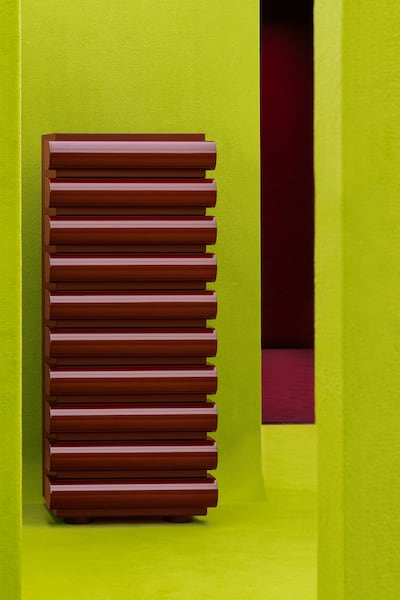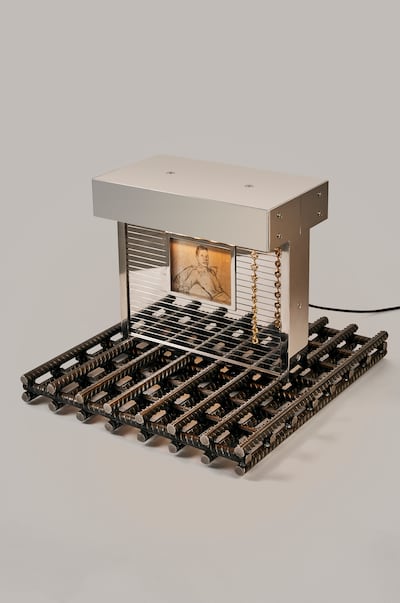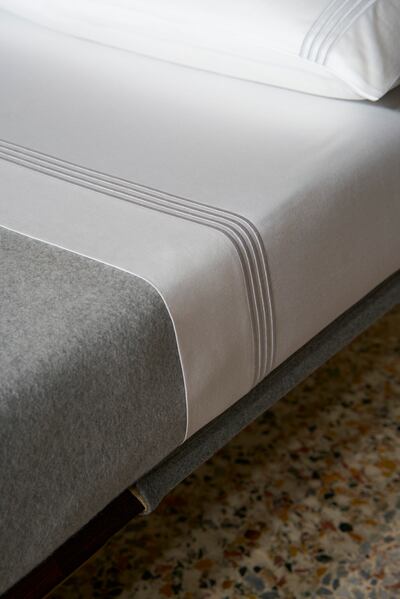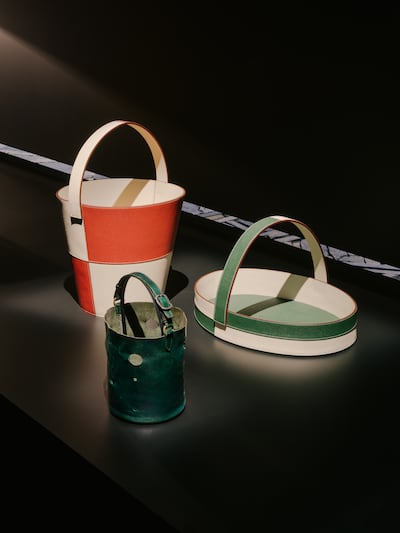MILAN — This year’s Salone del Mobile — the monumental design fair ending Sunday in Milan — features nearly 2,000 design companies and is set to welcome over 300,000 visitors, including design professionals, retailers, press and wealthy clients.
But for fashion brands, the action happens “fuori-Salone,” where the number of satellite events around the city including exhibitions, smaller fairs and brand activations has grown to new proportions in recent years. Since Milan’s Expo 2015 (a breakthrough year for the city’s international reputation and tourism), global luxury brands have realised the powerful marketing possibilities of Milan Design Week (the umbrella term for the fair and satellite events, still more often referred to as simply “Salone”).
Brands’ approaches vary, but expanding awareness, elevating their image and reinforcing a sense of intellectual authenticity both inside and outside the fashion sphere appear to be common goals. A handful of them, such as Hermès and Loro Piana, have also built real businesses in the space.
After all, the idea that a plate, vase or rug can be imbued with a brand’s DNA is as valid as suggesting the same about a shoe, handbag or jacket — and often with a greater possibility of holding value over time. Homeware is a highly dynamic market, with 41 percent of high net-worth shoppers in the US, UK and France citing furniture, decor, textiles, fragrances and tableware as a top spending category in 2023, up 12 percentage points since before the pandemic, according to a survey by BoF Insights.
But creating design objects and furniture involves different processes and timelines from fashion, often requiring high investments in industrial production or laborious artisanal processes. At Milan Design Week 2024, a few brands decided to produce design pieces in larger, un-numbered quantities, whilst most opted to produce limited editions of ‘collectible design’ or even one-off pieces that are as close to haute couture as a chair or lamp can get. Some brands chose to barely produce anything at all, using Salone simply as a marketing moment — staging installations, exhibitions and cocktail parties that had little or no connection to real-world product.
Hermès Gallops Ahead
Hermès continued to demonstrate its commitment to the home category — staging an exhibition for its Métiers collection in the same concrete space that hosted its first Salone outing in 2011.
Since then, Hermès has set the benchmark for an international approach to interdisciplinary design, quietly calling upon known design world names and artisanal specialists to enrich their offer of equestrian-inspired cashmere plaids and cushions, vegetal leather chairs and cane sofas, as well as a plethora of porcelain services. To celebrate the slowly-but-surely expanding collections piloted by Hermès Maison creative directors Charlotte Macaux Perelman and Alexis Fabry, the brand has called on dramatic dance troupes, performative caterers and other artists to create large, atmospheric installations.
This year, a rustic temporary floor was inlaid with meticulous patterns echoing jockey silks, rendered in natural materials like adobe, terracotta, “parquet” and stone. A floating bridge led guests over the floor to where the collection had been laid out in dialogue with items from the Hermès archives.
At a dinner inaugurating the show, Hermès artistic director Pierre-Alexis Dumas said the event aimed to underscore house’s relationship with time and patrimony: a new hammered aluminium chair was slung with bridle leather — evoking Hermès’ equestrian roots — and displayed next to a historic silver necklace, while the pattern on a pair of 1950s gloves had inspired a hand-painted elm wood jewellery box.
Gucci’s New Directions
Gucci brand has less of a presence in homeware and design, despite having entered the space over a decade ago by acquiring Tuscan porcelain manufacturer Richard Ginori. During Salone, Gucci showed the first examples of how new creative director Sabato de Sarno’s more sleek and polished vision could translate to design.

In a concise and stripped-back exhibition above its Via Montenapoleone store, the brand applied its new “Gucci Ancora” signature shade of deep red to five historic creations for the home by canonical Italian designers. The items (curated by design consultant Michela Pelizzari) took on a new chromatic intensity when displayed within a shocking lime green space carpeted by Spanish architect Guillermo Santoma. Gucci’s project celebrates well-known Italian classics: the bulbous leather Tacchini sofa by Mario Bellini, a mosaic rug designed by Piero Portaluppi and edited by CC-tapis, a opaque Venini glass vase by Tobia Scarpa, a rounded porthole table lamp by Gae Aulenti and Piero Castiglioni for FontanaArte, and Nanda Vigo’s columnar Acerbis cabinet in lacquered poplar wood.
The items were immediately made available for purchase in the latest sign that big luxury brands want to make conversions — not just conversation — with their design outings. Pieces were priced in line with the higher end of Gucci’s fashion and accessories offer, begging consumers to question: a vase or a handbag? A sofa, or a beaded ball gown?
Loewe’s Exploration of Light
At Spanish leather goods house Loewe, creative director Jonathan Anderson’s elevated and eclectic taste has won the brand legitimacy to participate in the upper echelons of art, craft and design. Having presented ambitious displays at Salone since 2015, this year’s Lamps exhibition was no exception.
In a stripped-back subterranean bunker in Brera’s design district, Anderson asked 24 contemporary artists and craftspeople to think about light, commissioning unique artist lamps that combined their maker’s signature sculptural practice with added function and artistic conceit. For some, like the Welsh artist Cerith Wyn Evans — who often uses neons and glass in his suspended sculptures — the commission was not a far cry from their regular practice. For others, the challenge was more considerable and yielded unexpected results, like the Kenyan sculptor Magdalene Odundo’s spiked leather lamps that mirrored the jagged edges of her burnished ceramic vessels.

Through materials like bamboo and leather, one could draw direct links to Loewe’s commercial output in the show, made material through the exhibition’s “exit through the gift store” strategy: a selection of artisanal Loewe handbags and homewares was available for purchase in an ephemeral store adjoining the show.
Bottega Veneta x Cassina
Also perpetuating a historical link to leather and weaving, and in particular the criss-crossed “intrecciato” technique that remains synonymous with the brand, Bottega Veneta opened a public exhibition on the site of their future headquarters on the Piazza San Fedele to showcase a partnership with the Fondation Le Corbusier and high-end Italian furniture manufacturer Cassina. Revolving around the LC14 Tabouret Cabanon — a box-jointed wooden crate with cut-out handles — the project was teased at the brand’s Autumn/Winter 2024 fashion show in February, where guests sat on a burned, patinated wood version. In two monumental piles reaching up toward the silo-like office’s circular ceiling, the €2,500 burned boxes (of which only 100 will be sold) were interspersed with even-more limited editions: boxes covered in deep-hued Intreccio leather darkened by nuances of black paint, priced at €12,000 each. By displaying the new pieces side-by-side with a Scotch whiskey box that inspired Le Corbusier’s original design — worthless (yet now, somehow priceless) debris — the brand posits an authentic connection with the past. The activation adds value to an existing design object through new layers of craftsmanship, whilst bolstering the brand’s own relevance, forging links with one of the last century’s most celebrated designers.
City-Wide Takeover
Elsewhere in the city, fashion brands continued to seek out ways to build and engage their audiences through the lens of design. Some, like Bottega Veneta with Cassina, aligned with specialised design companies to produce collaborations that benefit both parties. Saint Laurent commissioned Ginori 1735 (also owned by Kering) to produce a set of brightly coloured and gilded porcelain plates originally designed by the Italian maestro Gio Ponti for a famous villa in Caracas, Venezuela. Thom Browne linked with Frette, an Italian linen company founded in the 19th century, to create a collection of sheets, pillowcases, cashmere cushions and bath towels featuring his iconic four-stripe motif. Milanese luggage house Valextra teamed up with Bergamo design office Studio Temp to stage a takeover in the Rinascente department store — using the occasion to launch a curvy, 3D-printed handbag engineered from corn protein, a leather restoration service and sleek men’s nylon collection.
Loro Piana — which, like Hermès, has built a substantial homewares business anchored in its fabric-making prowess — delved into the archives of the late Italian designer Cini Boeri, re-editing her designs in the house’s neutral cashmeres and shaved shearling finishes, on what would have been her centenary year. The collection includes a low, Japanese-inspired dining chair as well as a modular zipped bed covered in soft padding (Loro Piana Interior’s design director remembered sleeping on one as a child). After 2023′s artistic installation of towering cashmere totem poles by the Argentine designer Cristian Mohaded, this year’s project represents a move in a more commercial direction: the sofa and chairs will be produced by the Milanese editor Arflex and sold at regular re-edition prices albeit heightened to reflect the value of their luxurious upholsteries.

For brands with established homeware extensions like Fendi and Versace — which have worked with partners to emblazon FF monograms and Medusa motifs across sofas, fine china and bedsheets for decades — Salone is often more about selling their collections than starting a conversation. (Versace still made an event of it by staging the latest products from its various homeware and furniture licensees in the palazzo where founder Gianni used to live.)
Prada’s Symposium
On the other end of the spectrum from countless product-centric launches — from Etro’s tapestry chair to a Sunnei rainbow carpet — the Prada Group continues to invest in a less tangible approach. Miu Miu inaugurated a new literary club format on Wednesday, while Prada staged the third edition of its “Frames” symposium curated by Formafantasma, which has established itself as a crucial hub during Salone for philosophical and scientific discussions on the state of design. This year, speakers included MoMa curator Paola Antonelli, French political theorist Françoise Vergès and the actress and activist Isabella Rossellini. Talks explored the urgent need for collective action and recognition of global design issues that impact housing and the movement of peoples in crisis worldwide. With no gift shop in sight, Prada’s Salone moment is undoubtedly one of the week’s least commercial yet most enriching projects.
Adding pressure to 2024′s Salone was the fact that many editors and guests were obliged to leave Milan earlier than usual, as the design week’s dates overlapped with previews for the Venice Art Biennale, prompting brands to cram in openings and events over the weekend. Some longstanding guests griped at the multiplicity of activations — not all of which were rooted in credible or innovative design — and swelling crowds of visitors who seemed more interested in the event’s free-for-all social aspect. While the calendar felt busier than ever, some fashion brands that had staged big activations in previous editions sat this year out (notably LVMH’s Louis Vuitton and Dior).
Still, projects like Prada’s enriching talks program and Loewe’s cross-disciplinary experiment underscore why Salone is likely to remain a critical petri dish for dalliances between design and fashion. They are curious bedfellows who have much to gain from each other when synergies are authentic, thought-through, and built to last.

